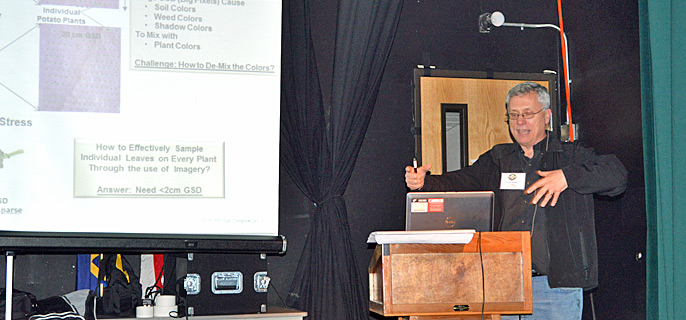
When it comes to efficient, high-production farming, success is in the details.
And when it comes to details, nothing tops unmanned aerial vehicles for giving a farmer the clearest, most precise picture of what his or her crops need in terms of fertilizer, pesticides, herbicides and water. But, according to Gene Bruce, one of the speakers at Wednesday’s opening day of the 40th annual Farm Fair at the Hermiston Conference Center, the use of UAVs on farms will not be common place until it becomes more cost effective.
“We need to get to a point where a single pilot can operate multiple UAVs in order to make it commercially viable,” said Bruce, an associate technical fellow with Boeing Research and Technology.
That day will come, said Bruce, because the benefits of UAVs in farming are huge. Using a UAV, a farmer can use the data collected during low-level flights over the field to develop a prescription plan for his acreage. It’s all part of the trend toward precision agriculture.
“The big push is for farmers to become more efficient,” Bruce said. “And the main driver behind precision agriculture is better production for the farmer.”
Unmanned aerial vehicles are remotely controlled on the ground and can fly over a field using technology that produces high-resolution photos that can capture images as detailed as individual leaves on individual plants. That information allows a farmer to know what areas of his land need individualized care. Depending upon a number of factors, plants in one area of a field may need more or less water or more or less chemicals than plants in a nearby section.
“Farmers need to identify where plant stress is to develop a prescription plan,” Bruce said. Better stress detection can lead to better prescription plans, which leads to better production at a lower cost.
Farmers already utilize aerial photography to develop prescription plans, but most farmer are getting their imagery either from satellite photography or manned aircraft – neither of which can provide the sort of detailed, close-up information that UAVs can provide.
“Today, the technology is vastly different that it was just a few years ago,” Bruce said.
Before UAVs become the industry standard, however, several things need to happen. First, more test flights need to take place. Already, tests have been conducted at Oregon State University’s Hermiston Agricultural Research & Extension Center, as well as on a local commercial potato farm. The technology will also have to develop to the point that a single pilot can operate as many as 10 UAVs at a time to make it more efficient and less expensive. And finally, by working with the Federal Aviation Administration, procedures on how UAV flights can be conducted will have to be developed.
“We’ve already been meeting with the FAA,” Bruce said. “If everything comes together, the hype of precision agriculture could actually come true.”









